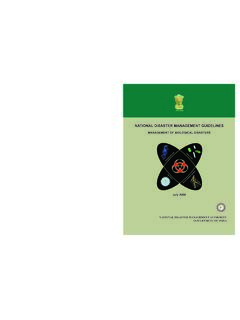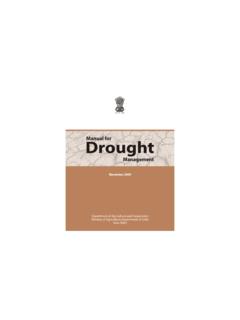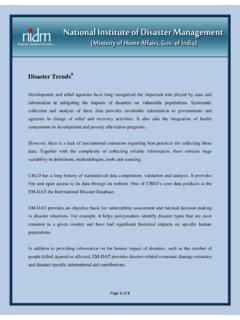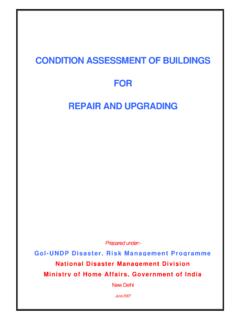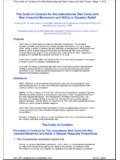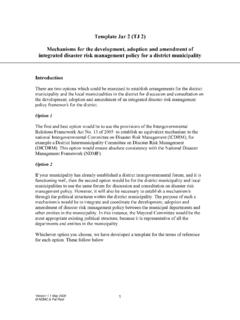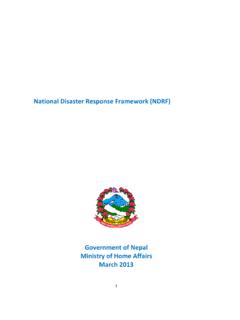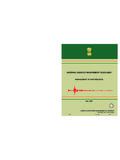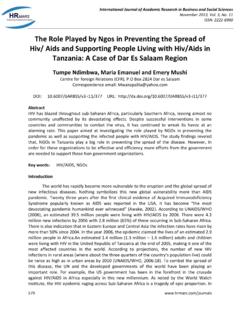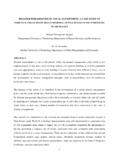Transcription of CHEMICAL DISASTER MANAGEMENT
1 NATIONAL INSTITUTE OF DISASTER MANAGEMENTMINISTRY OF ENVIRONMENT & FORESTSNIDM Building, 5-B, IIPA Campus, IP EstateMahatma Gandhi Road, New Delhi - 110002 Tel: 23702445, 23702432, 23705583; Fax: 23702446 Website: Bhawan, CGO Complex, Lodi Road, New Delhi - 110003 Website: DISASTERMANAGEMENTCHEMICAL DISASTERMANAGEMENTN ational Institute of DISASTER ManagementMinistry of Home AffairsMinistry of Environment and Forest Govt. of India 2009 MoEF and NIDMACKNOWLEDGEMENTSThe National Workshop on CHEMICAL DisasterManagement was organised by National Institute ofDisaster MANAGEMENT (NIDM) as a national consultationprocess towards Preparation of National Action Plan onChemical DISASTER MANAGEMENT . Financial grant wasprovided by the Ministry of Environment & Forests(MoEF) for conduct of workshop and printing of theproceeding workshop was organised under the supervisionand guidance of Shri P.
2 G. Dhar Chakrabarti, ExecutiveDirector, National Institute of DISASTER MANAGEMENT ,Ministry of Home Affairs, New Delhi and Dr. G. K. Pandey,Sr. Advisor and Dr. Chhanda Chowdhury, Director,Hazardous Substances MANAGEMENT Division (HSMD)in the Ministry of Environment & Forests, Govt. of Organising committee acknowledges thecooperation of dignitaries of inaugural session, subjectexperts on various themes, related agencies, corporate/industry, state authorities, non-governmentalorganisations, and all individuals who made theworkshop a success. Suggestions and Inputs from Khwaja, Additional Secretary, MoEF; Dr. IndraniChandrasekhran, Advisor, Planning Commission and Kumar, NIDM, and whole-hearted support ofShri J. N. Jha, Ms. Geeta Sharma, Shri Surinder Bisht andother staff members of NIDM are Anil K. GuptaAssociate Professor, NIDMS reeja S. NairAssistant Professor, NIDMShri ShardDeputy Director, MoEFCITATIONG upta, Anil K.
3 , Nair, Sreeja S. and Shard (2009). CHEMICAL DISASTER MANAGEMENT (Proceeding Voltional Institute of DISASTER MANAGEMENT , New Delhi. Pages of National Workshop on Preparation of Na-tional Action Plan). Ministry of Environment and Forests, Govt. of India and National Institute of DISASTER MANAGEMENT , New Delhi. Pages of the workshop .. DISASTER MANAGEMENT Guidelines .. Address .. 1 1 and International Status - Recent Development & Issues .. 1 based Emergency Planning & Response System .. 1 of Community Awareness for Emergency Preparedness .. 1 Building and Knowledge Needs .. DISASTER MANAGEMENT Framework .. 2 Health Dimension in CHEMICAL Incidents .. 2 Accident Information & Reporting System .. 2 Industry Safety Directorate .. 3 Institute of Toxicological Research .. 3 of Indian Chamber of Commerce & Industry .. 3 Council of Medical Research .. 3 and Explosives Safety Organisation.
4 3 General of Factory Advice Service and Labour Institutes .. 3 and Homegaurds .. 4 Pradesh .. 4 4 4 4 4 .. 4 .. 4 4 4 Nadu .. 4 5 Discussion and A: List of DISASTER ManagementContextIndia is developing as a key global player in the industrial and technology sector. Rapidindustrialization has increased the hazard, risk and vulnerability to the industry and theenvironment. Major CHEMICAL (Industrial) disasters are low in frequency but are very significantin the terms of loss of lives, injuries, environmental impact and property damage. Frequencyand severity of CHEMICAL disasters has increased in last few years due to rapid development ofchemical and petrochemical industries and increase in size of plants, storage and carriers,specifically in densely populated present there are over 1724 Major Accident Hazards (MAH) units and other small andmedium sized industries all across the nation and new industries are also establishing at a rapidrate.
5 CHEMICAL accidents can occur due to lack of safety measure, technical break down, or dueto a human error. It, thereby, initiates a series of uncontrolled physiochemical phenomenon suchas runaway CHEMICAL reactions, large spills, fires and explosions. These phenomenon eventuallytargets both human and non-human in the form of immediate and residual or long termconsequences. Thus, it is imperative to develop preventive measures like adoption of saferengineering practices, improved safety devices and elimination of human errors by regular Ministry of Environment and Forests (MoEF) and National Institute of DISASTER MANAGEMENT (NIDM), Ministry of Home Affairs, New Delhi jointly organized a two days National Workshop on CHEMICAL DISASTER MANAGEMENT during September 30 and October 01, 2008, at Mirza GhalibHall, Scope Complex, New workshop was aimed to facilitate a policy level national dialogue on issues and challengesin the area of CHEMICAL DISASTER risk MANAGEMENT at various levels in the country by assessingthe current status of prevention, preparedness, and MANAGEMENT for CHEMICAL disasters in thecountry, identify the gaps and develop a plan of action for implementation of the national policiesand the guidelines for MANAGEMENT of CHEMICAL disasters.
6 At present, various Ministries,institutions are involved in CHEMICAL DISASTER MANAGEMENT . At the national level NationalDisaster MANAGEMENT Authority, Ministry of Environment and Forest, Ministry of Home Affairs,Ministry of Labour & Employment, Ministry of Agriculture, Ministry of Petroleum, Ministry ofIndustry, etc. are involved with the the State level - State DISASTER MANAGEMENT Authority, Department of Factories & Boilers,Pollution Control Board, Department of Health, Police, Fire, Industry & Commerce, etc. aredirectly responsible for industrial accident related issues. There is a need to workout better andeffective institutional mechanism, coordination and strategies for ensuring synergy in thevarious activities of different Ministries and organization. A strategic framework is neededespecially towards capacity building and integration with holistic environmental riskmanagement within the framework of a multi-hazard risk reduction strategy.
7 The workshop hasprovided a platform for the authorities at the national and state level and subject experts to discussthe relevant issues, identify potential gaps and suggest solutions to address the DISASTER ManagementThe workshop was attended by 138 delegates representing Central Ministries/Departments,State Government Departments representing Environment, Pollution Control Boards,Directorates of Industrial Health & Safety/ Factories & Boilers, State DISASTER ManagementAuthorities, Revenue, Police, Medical, Transport, Corporate Sector, Industries and the leadinginstitutions like FICCI, CII, ASSOCHAM, NGOs, WHO, NSC, GTZ-ASEM, the enactment of the DISASTER MANAGEMENT Act, 2005 there is a paradigm shift in approachto DISASTER MANAGEMENT from post DISASTER relief and rehabilitation to pre DISASTER preventionand preparedness. The Act ordinates the Government to prepare a National Plan for (a) theprevention of the disasters or the mitigation of the effects and measures to be taken (b)integration of mitigation measures in the development plans and (c) preparedness and capacitybuilding to effectively respond to the threatening DISASTER situations or DISASTER .
8 The NationalPlan has to be prepared in consultation with the State Governments and expert bodies orother organizations in the field of DISASTER Ministry of Environment and Forest (MoEF) is the nodal Ministry for the MANAGEMENT ofchemical disasters. MoEF has taken a number of initiatives for the prevention and preparednessand response of CHEMICAL disasters. The Umbrella Act EPA, 1986 enacted after the incidence ofBhopal Gas Tragedy in 1984, and the rules MHIHC Rules 1989, MHWW Rules 1989, EPPR Rules1996, PLI Act 1991, besides Factories Act 1948 (amended thereafter) provided a systematicapproach to DISASTER MANAGEMENT framework at national, state, district and local levels, in thecontext of CHEMICAL accident MANAGEMENT and emergency response. NIDM is a statutoryorganization under the DISASTER MANAGEMENT Act 2005, mandated for training, capacity building,research, documentation, policy advocacy, knowledge MANAGEMENT and networking on issuesrelated to DISASTER risk reduction and MANAGEMENT .
9 NIDM supports a DISASTER ManagementCentre in the Administrative Training Institutes in each state for catering to the capacity buildingservices at state and district levels. Recently the National DISASTER MANAGEMENT Authority(NDMA) has issued National DISASTER MANAGEMENT Guidelines for CHEMICAL Disasters. TheGuidelines have laid emphasis on capacity building, risk assessment, information managementand coordination of actions for enhancing the preparedness at various levels. Based on theseGuidelines, a National Plan of Action for MANAGEMENT of Industrial and CHEMICAL DISASTER isrequired to be of the Workshop To review the present scenario of CHEMICAL DISASTER Vulnerability and Risk in differentregions of India To evaluate the present level of Institutional and legal framework and identify the gapsand critical challenges in addressing CHEMICAL DISASTER preparedness issues To identify and address the various mechanisms of managing information on chemicalaccident risk MANAGEMENT and preparedness and capacity building needsIntroduction3 CHEMICAL DISASTER MANAGEMENT To develop a framework for the preparation of an action plan for the MANAGEMENT of thechemical DISASTER risk and strategy for implementation of the action DISASTER MANAGEMENT GuidelinesThe National Guidelines have been formulated as part of an integrated national all-hazardapproach for the MANAGEMENT of disasters.
10 The prime objective is to ensure that the occurrenceof CHEMICAL accidents are minimised and risks posed to life, environment and property arereduced. The National DISASTER MANAGEMENT Guidelines CHEMICAL Disasters document callsfor a proactive, participatory, well-structured, fail-safe, multi-disciplinary and multi-sectoralapproach involving all stakeholder groups, aimed at refining and strengthening the variousmechanisms from stages of planning to field operations. These guidelines contain details thatare required by the planners and implementers and will help in the preparation of plans bythe central ministries/departments and the has been a paradigm shift in the government s focus from its rescue, relief, and restoration-centric approach to a planning, prevention/mitigation and preparedness approach. It has beenrealised that effective CHEMICAL DISASTER MANAGEMENT (CDM) is possible by the adoption ofpreventive and mitigation strategies as most CHEMICAL disasters are preventable in comparisonto natural disasters that are difficult to predict and the gravity of the risk posed by Hazardous Chemicals the National DisasterManagement Authority (NDMA) took up the task of strengthening CHEMICAL DisasterManagement.
